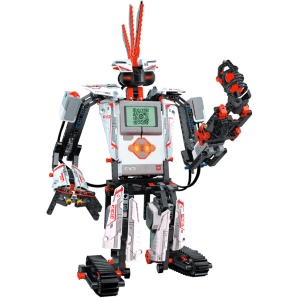In 1998 Lego introduced its first version of Lego Mindstorms sold as the Robotics Invention System (RIS). Although this first version proved popular, it wasn’t until 2006 and the release of Lego Mindstorms NXT that Lego and robotics really took off. The latest version is the Lego Mindstorms EV3 released in January 2013.
In 2015 LEGO released a number of free app allowing you to program and control your robot from an Apple or Android device.

The LEGO Mindstorms kit is comprised of a Central Processing Unit (CPU) called the ‘NXT Brick’. This controller has four input and three output ports; The standard input sensors are: a push switch; a microphone; a light-sensor and an ultrasonic sensor. The standard Mindstorms kit comes with three servo motors each with a built-in rotation sensor.

Overview
The biggest change from the Lego Mindstorms NXT and NXT 2.0 to the EV3 is the technological advances in the programmable brick. The main processor of the NXT was an ARM7-based microcontroller, whereas the EV3 has an ARM9-based processor running Linux. A USB connector and Micro SD slot (up to 32GB) are new to the EV3. It comes with 5 models: EV3RSTORM, GRIPP3R, R3PTAR, SPIK3R, and TRACK3R. Lego has also released instructions online to build 12 additional models from the set; ROBODOZ3R, BANNER PRINT3R, EV3MEG, BOBB3E, MR-B3AM, RAC3 TRUCK, KRAZ3, EV3D4, EL3CTRIC GUITAR, DINOR3X, WACK3M, and EV3GAME.
The EV3 Home (31313) set consists of: 1 EV3 programmable brick, 2 Large Motors, 1 Medium Motor, 1 Touch Sensor, 1 Color Sensor, 1 Infrared Sensor, 1 Remote Control, cables, USB cable, and 585 TECHNIC elements.
NXT sensors and motors can be used with the EV3.
| EV3 | NXT | RCX | |
|---|---|---|---|
| Release Date | September 2013 | july 2006 | 1998 |
| Display | 178×128 pixel Monochrome LCD | 100×64 pixel Monochrome LCD | segmented Monochrome LCD |
| Main Processor | TI Sitara AM1808 (ARM926EJ-S core) @300 MHz | Atmel AT91SAM7S256 (ARM7TDMI core) @48 MHz | Hitachi H8/300 @16 MHz |
| Main Memory | 64 MB RAM 16 MB Flash microSDHC Slot | 64 KB RAM 256 KB Flash | 32 KB RAM 16 KB ROM |
| USB Host Port | Yes | No | No |
| WiFi | Optional dongle via USB port | No | No |
| Bluetooth | Yes | Yes | No |
| Connects to Apple devices | Yes | No | No |
Compatibility
All NXT sensors, motors, and building elements work with EV3 and are recognized as NXT sensors/motors when plugged in. EV3 sensors do not work with the NXT, but EV3 motors do. The NXT brick can be programmed with the EV3 software, but lacks some software features. When you use the EV3 software to program the NXT, you must download extra programming-blocks, such as the UltraSonic sensor (which is included in the standard NXT kit, but not the standard EV3 kit). The EV3 brick cannot be programmed with the standard NXT software, but some third party software supports both systems.
Notable robots made with the EV3 platform
- The Braigo is a robotic Braille printer designed by Shubham Banerjee, a 12-year-old boy from Santa Clara, California in the Silicon Valley region. Its low cost (US$354) is an advantage over typical Braille printers (which can cost upwards of $2000).
- The CubeStormer III is a Rubik’s cube solving robot, that holds the current Guinness World Records record for the fastest Rubik’s Cube solving robot – 3.256 seconds. The previous record of 5.27 seconds was held by the CubeStormer II, which was built with previous generation NXT parts. The CubeStormer III broke the record on March 15, 2014.
- The Lego Bookreader is a digital book reader made from the EV3 kit that can digitize paper books.
Visit LEGO website to read more »
External Links:
- Detailed article about LEGO Mindstorms
- LEGO NXT Projects and ideas for creating your own LEGO creations
- LEGO guide to how gears work
